Author: William M. Peaster
Compilation of the original text: The Way of DeFi

Image Credit: Generated by Maze AI
Author: William M. Peaster
Compilation of the original text: The Way of DeFi
image description
Image Credit: Generated by Maze AI
If you've been into the crypto world, you've heard about Zero-Knowledge Proofs (ZK Proofs) and their applications for a while now. Are they live...or very close to it...or is a version of them just around the corner? This information is difficult to track.
How is ZK progressing?
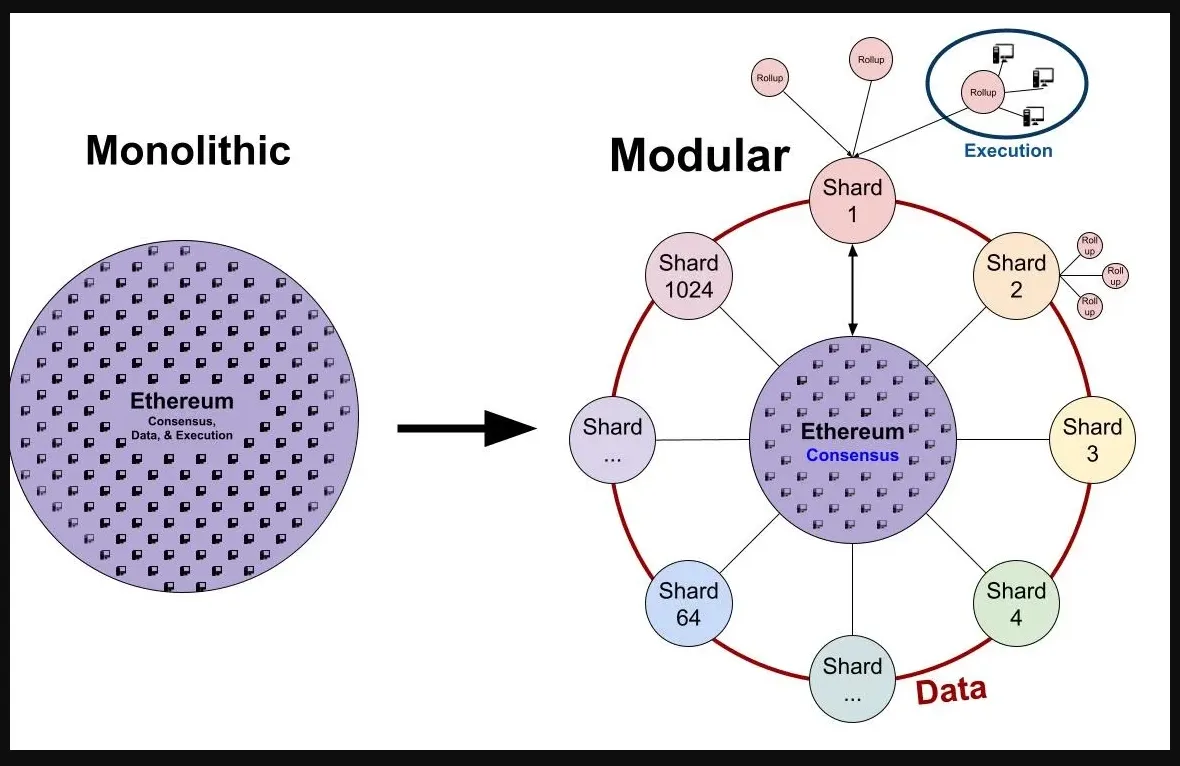
In blockchain terms, we think of the initial phase of Ethereum's life as a monolith.Ultra Scalable Ethereum
This means that, for the first few years, the "Layer 1 (L1)" Ethereum mainnet is solely responsible for executing its own transactions, facilitating its own network security, and providing services for its own data availability.
Over the past few years, Ethereum has been rapidly moving towards a modular design, meaning that external third-party solutions built around Ethereum are increasingly being used to scale Ethereum's data and execution needs.
Modular Ethereum丨Source:
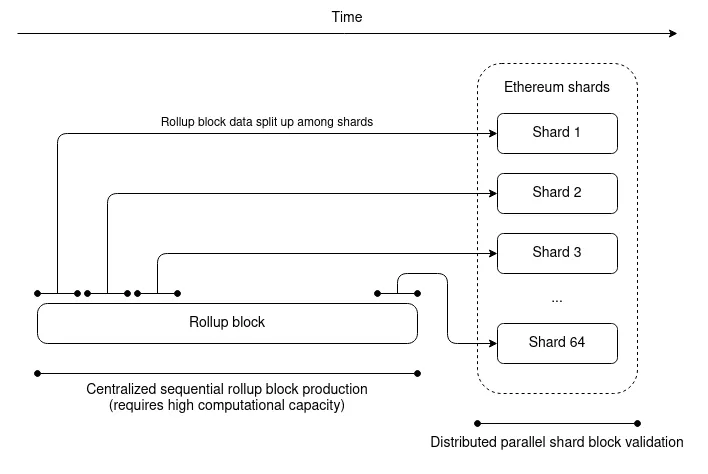
When it comes to data availability, projects like Celestia and Polygon Avail are contenders. As for execution, in recent years we've seen the rise of "layer two (L2)" like Arbitrum and zkSync, which execute transactions outside of Ethereum (i.e. off-chain) and then effectively "rollup" the transactions in batches. ) to Ethereum L1, providing an incredibly affordable and fast user experience in the process.Vitalik Buterin
Today, Ethereum L1 itself facilitates a measly ~30 transactions per second (TPS). To better handle global activity levels without severe network congestion (high fees, slow transactions), Ethereum increasingly relies on scaling innovations to optimize its ability to execute. There are two main types of solutions here: on-chain scaling and off-chain scaling.
On-chain scaling refers to changes made directly to a blockchain to increase its transaction execution capabilities, i.e. throughput speed. For Ethereum, one example is sharding, an innovation once implemented that would spread the load of activity across dozens of main, enshrined Ethereum chains rather than a single mainnet.
image description
The future of Ethereum L2 + sharding - from
Off-chain scaling refers to the external execution environment, L2, which facilitates cheap and fast transactions outside of Ethereum, and then batches transaction data to Ethereum to complete the activity and inherit the security of Ethereum. Instead of dividing L1 into many main chains like sharding, off-chain scaling fosters a secondary layer consisting of many external rollups, which are very customizable.
ZK rollups: leading ZK-based off-chain expansion technology
When it comes to L2, the most popular contemporary solution is zero-knowledge rollup (ZK rollup). Notably, these rollups can facilitate approximately 2,000 TPS, a 6,500% increase over Ethereum's current rate of 30 TPS!
This particular L2 flavor uses "zero-knowledge proof (ZKP)" techniques, such as SNARKs, to cryptographically verify and publish batches of their transactions on Ethereum. So combine off-chain execution with on-chain data via Zero-Knowledge Proofs (ZKP) and you get ZK rollups (as opposed to combining off-chain execution with on-chain data via Fraud Proofs to get Optimistic rollups).
In summary, the five largest ZK rollups currently tracked by L2 BEAT are as follows:
Loopring — L2 for Transactions, NFTs | $121M TVL
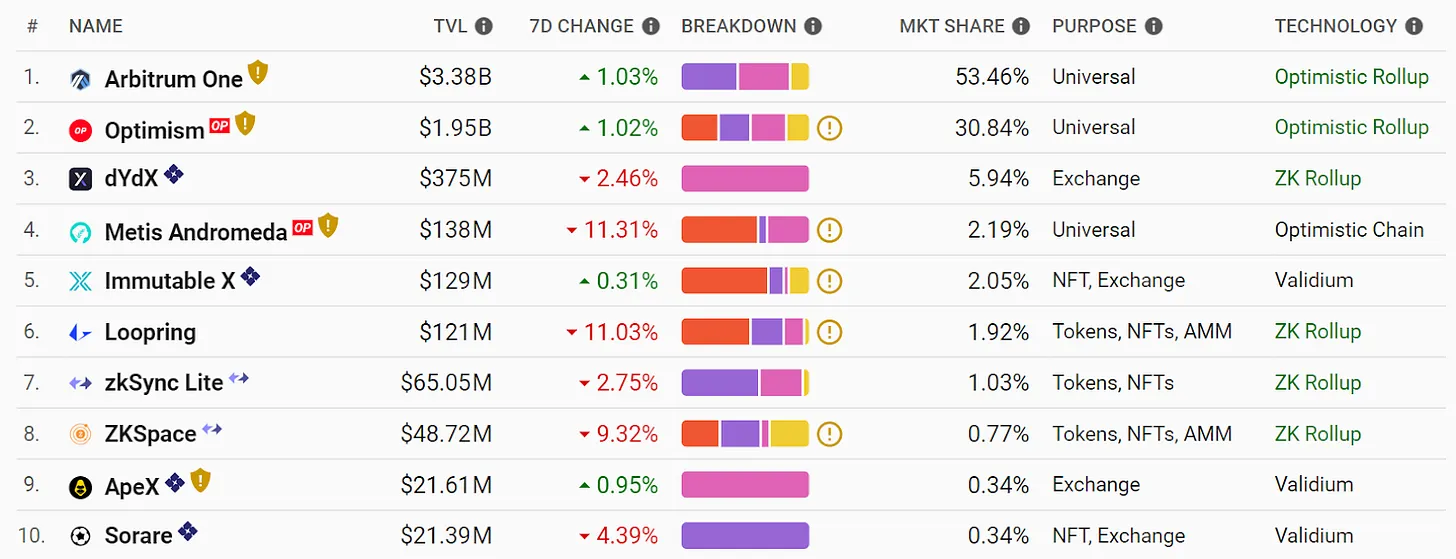
zkSync Lite — for transactions, L2 for NFTs | $65M TVL
ZKSpace — for transactions, L2 for NFTs | $49M TVL
Aztec Connect — L2 for Private DeFI | $15M TVL
image description
Four of the 10 largest L2s today are ZK rollups - via L2 BEAT
Today's leading ZK rollups are built using StarkEx technology (such as dYdX and Loopring) or zkSync-based code (such as zkSync Lite and ZKSpace). However, there are more ZK rollups that are not linked to these stacks that deserve your attention, such as Aztec Connect.
About Validiums and Volitions
Validiums' "dual off-chain" approach makes them ultimately custodial, as data is maintained by trusted parties. However, what validiums lack in trustlessness, they make up for in excellent performance, as the most powerful validiums today can facilitate + 20,000 TPS.
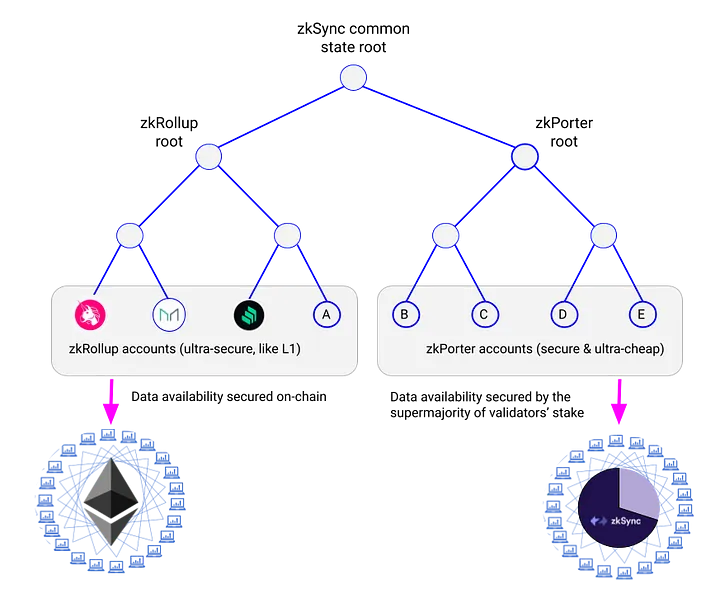
Image Source:Matter Labs
Currently, two of the more well-known validium projects are Immutable X, an NFT-centric scaling solution with a TVL of $123 million, and Sorare, a fantasy sports digital card game with a TVL of $21 million. Other validations worth looking at right now include ApeX, rhino.fi, and Myria.
As for Volitions, they are an innovation created by the StarkWare team, they are a cross between ZK-rollup and validium. That said, users can choose between on-chain and off-chain data availability whenever they want. This gives applications the option of a TPS performance-proven level, while still being interoperable with unmanaged ZK-rollup technology. One volition system worth noting is zkSync's new breakthrough zkPorter mechanism.
Image Source:
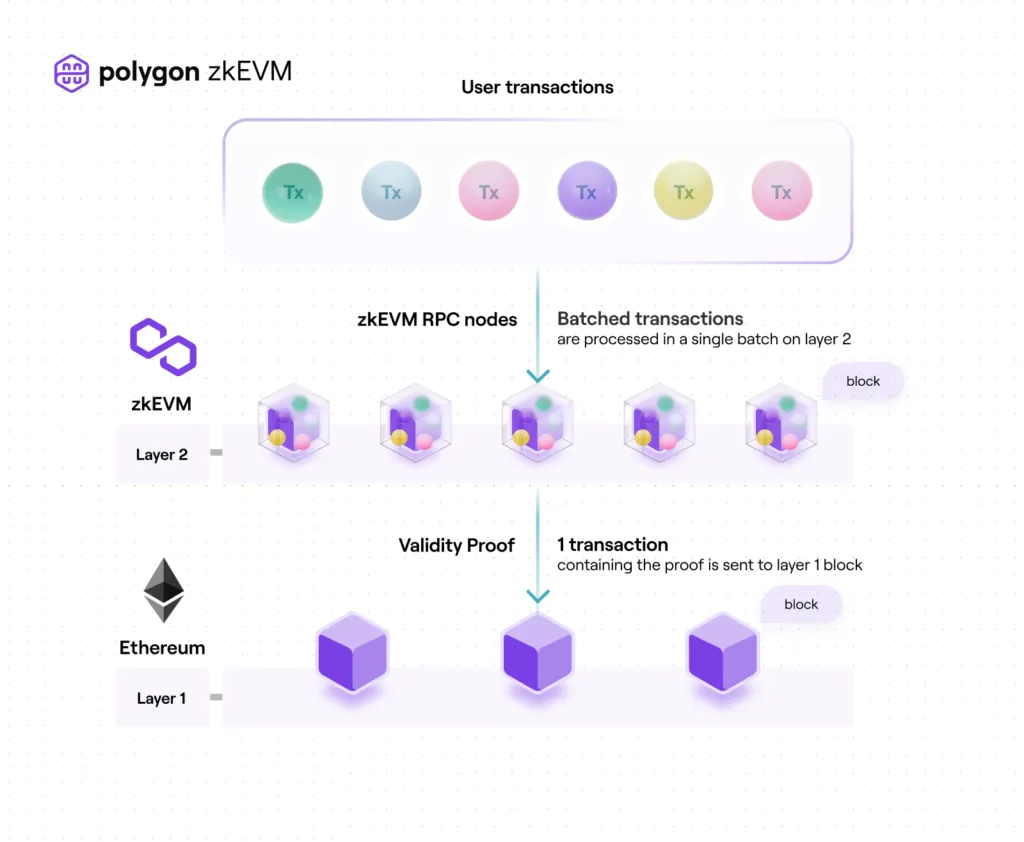
zkEVM as the holy grail of scaling
Consider how ZK-rollup's architecture consists of two main components: an on-chain Ethereum smart contract that receives and tracks L2 block data, and an off-chain virtual machine (VM) that acts as the execution environment for Ethereum-based transactions.
The zkEVM, then, is a ZK-rollup compatible with the Ethereum Virtual Machine (EVM), the execution environment for Ethereum L1.
image description
Illustration of general extension methods for Polygon zkEVM
At the beginning of the Ethereum scaling race, optimistic rollups like Arbitrum and Optimism have a huge advantage, because this style of rollups is initially easier to be compatible with or even fully equivalent to the EVM. This technical affinity allows applications to easily port their code and use their favorite tools for migrating from L1 to L2, which is great UX.
The arrival of zkEVM thus represents a major step forward in Vitalik Buterin's 2021 prediction that "in the medium to long term, as the technology improves, ZK rollups will win in all use cases." Thanks to the use of cryptographic proofs, ZK rollups are faster than Optimistic rollups have built-in privacy and security benefits, so when you add EVM compatibility into the mix, ZK rollups have the potential to outperform optimistic rollups in the future.
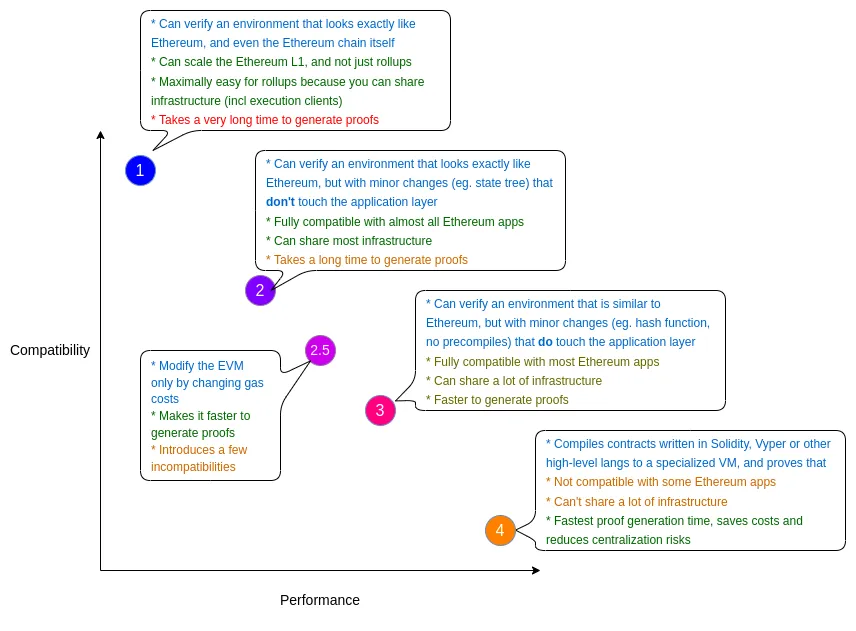
Ongoing competition between Type 1 and Type 2 zkEVMs
The term "scaling wars" refers to the friendly, informal competition that takes place between optimistic rollups and ZK rollups teams to deliver the best possible blockchain scaling solution.
image description
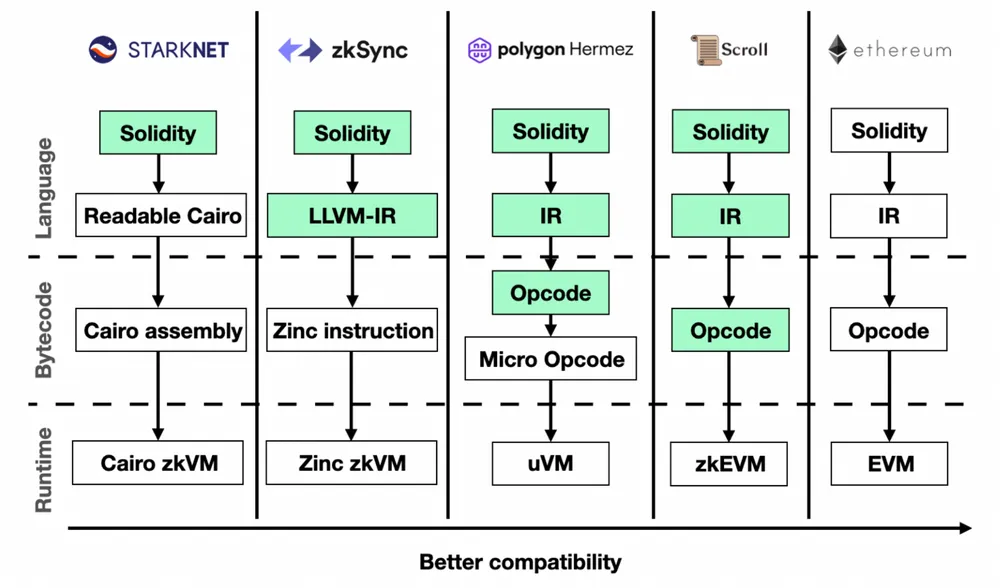
Buterin's zkEVM typeImmutable X
In an August 2022 blog post, Buterin provided a way to measure the capabilities of zkEVM projects by proposing a scale from Type 1 to Type 4 to grade them. Type 1 zkEVM will be fully equivalent to the EVM and can even be used to upgrade Ethereum itself, while Type 4 zkEVM will only be compatible with certain Ethereum applications.
Current major zkEVM efforts丨Source:
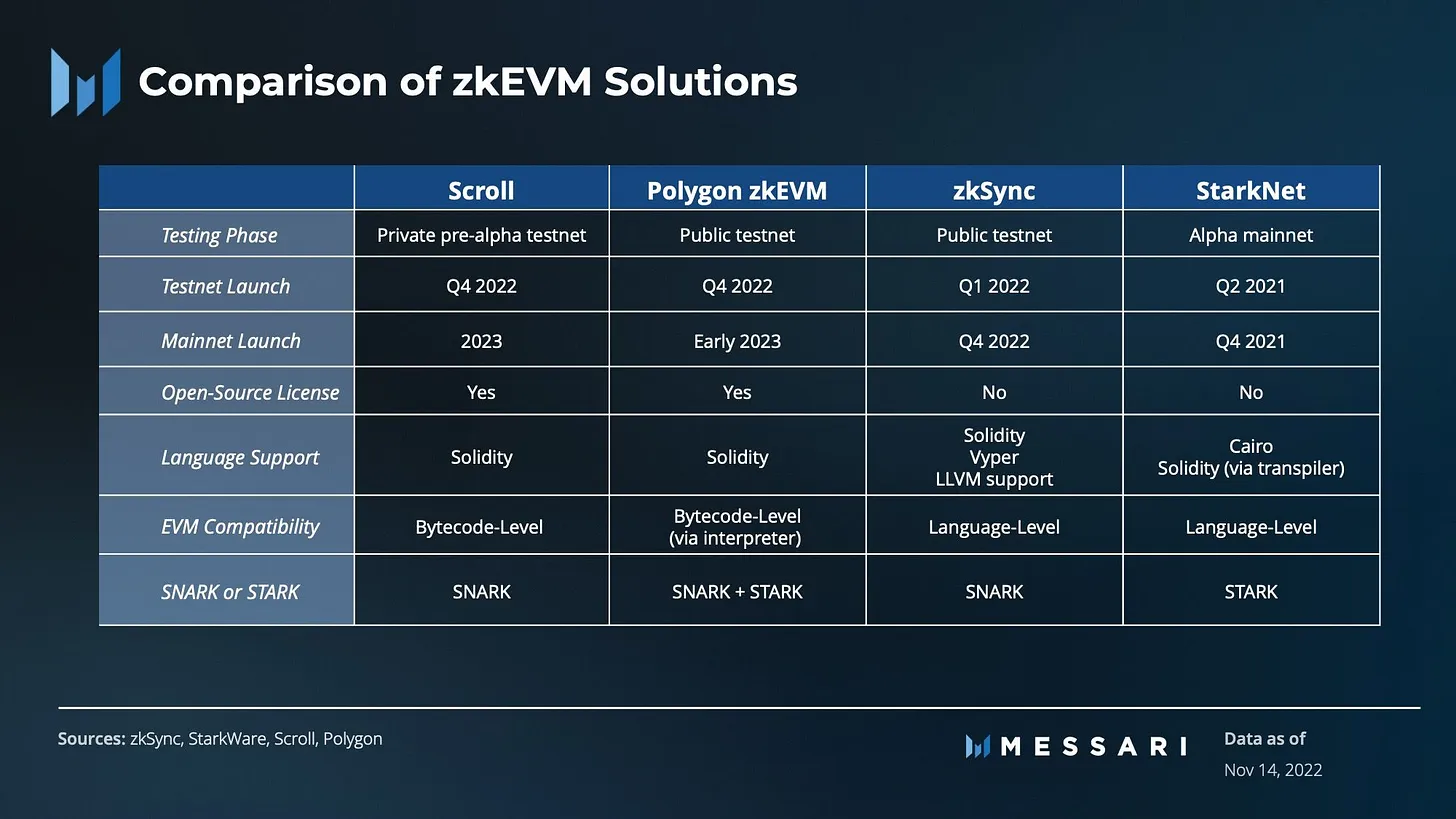
source:Messari
For example, Polygon zkEVM is a Type 3 zkEVM and is becoming a Type 2 zkEVM, the EVM equivalent with some additional nuances. Scroll is another notable team currently building the Type 2 zkEVM. In contrast, zkSync Era (formerly known as zkSync 2.0) is an opinionated, intentional Type 4 zkEVM enhanced with custom features and zkPorter's impressive willpower capabilities. Accordingly, the range of possibilities is wide open here.https://twitter.com/0x Polygon/status/1625529122561597440
The latest zkEVM progress so farhttps://twitter.com/zksync/status/1626235292268240902
image descriptionhttps://twitter.com/Scroll_ZKP/status/1630258973856395264
source:https://twitter.com/dimahledba/status/1606270836922585098
The Polygon zkEVM mainnet beta will start on March 27th:
The zkSync Era just launched mainnet to builders, and a version available to regular users is coming soon:
Scroll just released the Goerli zkEVM testnet, the last step before the mainnet goes live: